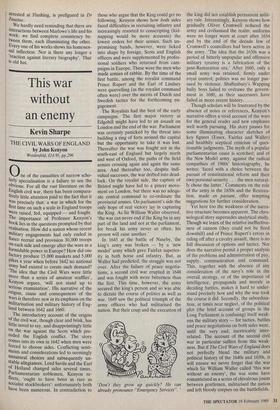Truth about Marlowe
A. L. Rowse
CHRISTOPHER MARLOWE AND CANTERBURY by William Urry
Faber, £12.95, pp.184
Dr Urry knew more about the history of Canterbury and, by consequence, Christopher Marlowe, than anyone has ever known. But he was one of those people who can't see the wood for the trees and could never get his work into publish- able shape. He left behind him an amor- phous mass of manuscript out of which this shapely little book has been excavated with an informative introduction by the editor, Andrew Butcher. It tells us all that is to be known about Marlowe's life, family, education there and at Cambridge, the whole Canterbury background.
The most important point is that it puts paid to the nonsense that there was any hanky-panky about Marlowe's death. We already knew from the coroner's inquest that the quarrel arose about 'le reckoning', and that Marlowe struck with a dagger at Ingram Frizer, who struck back in self- defence, and got into no trouble therefore. Urry goes in detail into the personalities and records of the persons present, and shows that the verdict was arrived at unanimously by 16 jurors who were all solid middle-class citizens with no interest in the affair except to get at the truth• There was no fuss because everybody knew what Marlowe was like: he had several times been involved in affrays, one of them fatal, and was 'given to sudden privY injuries to men'.
We learn that Mrs Bull's house was a respectable one, and that she served at least eight meals, dinner and supper that day to four men. So the reckoning must have been a big one — as William Shakespeare registered, referring to it in As You Like It, about 'striking a man more dead than a great reckoning in a little room.'
So I hope we shall hear no more nonsense about Marlowe's having been made away with for reasons unknown — a great bore. It does a disservice to go on circulating it, and it shows a volatile, rather haphazard notion of the way things were in that age. Urry had already brought to light something new in a last visit of Marlowe to his home town the year before. Then be was involved in an assault, outside the Chequers inn, upon William Corkine, the musician who set 'Come Live with Me and Be My Love' to an air. A great deal more of value emerges from this book, above all the way in which the circumstances of Canterbury life are re- flected in Marlowe's work. There was acute religious conflict between Catholics and Protestants; several of Marlowe's school fellows defected to Rome; another, Henry Jacob, became a Puritan sectarian leader and floated off to America. Canter- bury had a considerable element of Huguenot refugees — an interest reflected in The Massacre at Paris. Marlowe's attempt at coining, for which he was arrested at Flushing, is prefigured in Dr Faustus.
We hardly need reminding that there are interactions between Marlowe's life and his work: we find complete consistency be- tween them, each illuminating the other. Every one of his works shows his homosex- ual inflection. Nor is there any longer a reaction against literary biography'. That is old hat.



















































 Previous page
Previous page